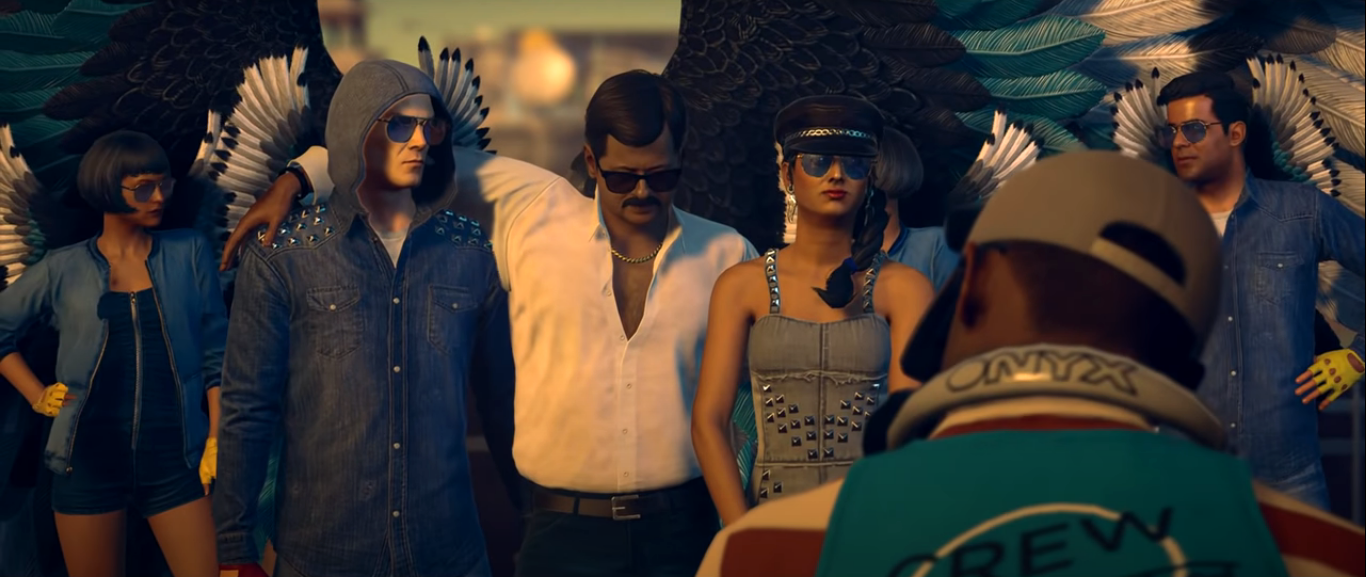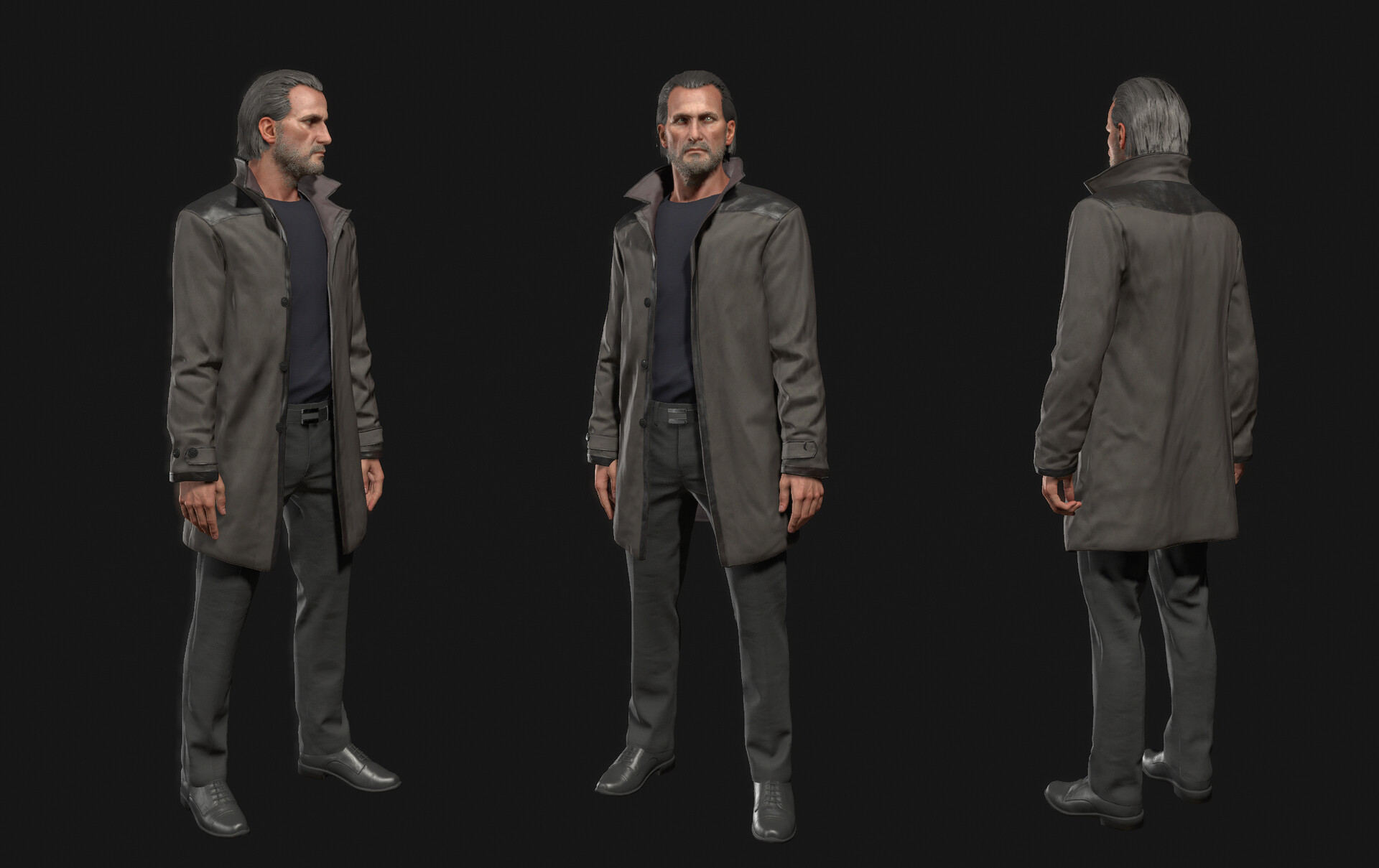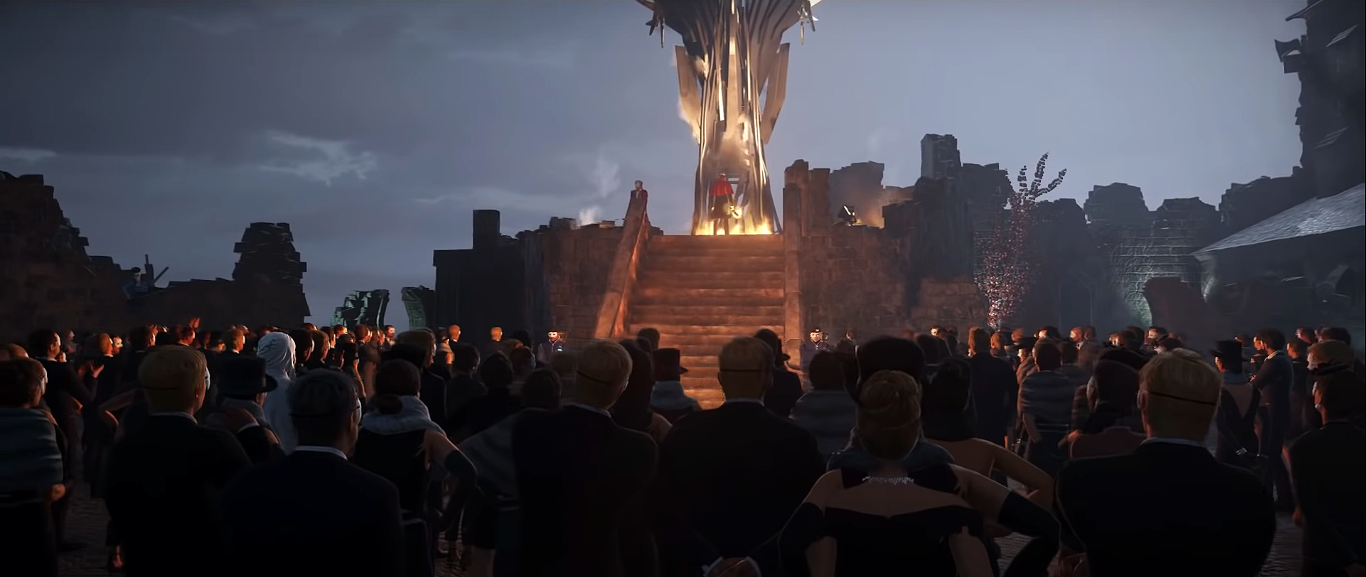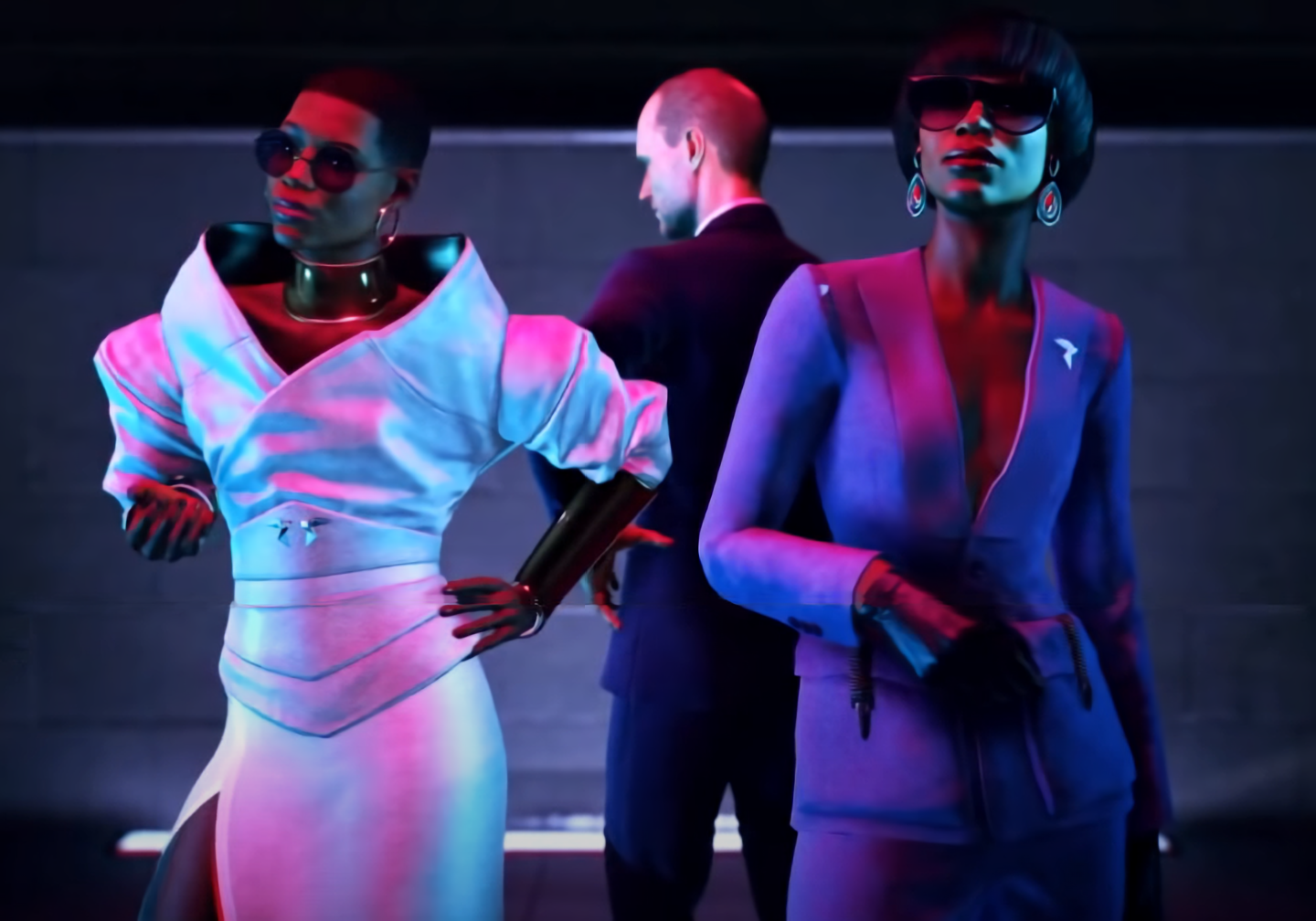
As we head into the second half of Hitman 2, the clues we’ve gathered are finally starting to congeal. We have Lucas, who won’t stop until Providence is destroyed. We have Providence, who won’t stop until they get their grubby little fingers in everything. We’ve even had our first look at the organization’s leaders, and learned that our representative is a lot higher up than he first seemed. We also sense that Lucas has history with 47, while 47 still has no idea who he is. From here, the changes in narrative continuity will accelerate, adding new connections and Codename 47-esque twists. Let’s not get ahead of ourselves, though. We’ve still got some targets to hunt. What we see after our next mission will put all the pieces in place.
Before we set off, Diana makes an important pit stop. She finishes her Colombia briefing on the way to the Burnwood cemetery. As she reflects on her family’s graves, we see a flashback cutscene that some fans refer to as Diana’s “Batman backstory.” Originally, we knew Diana as a wealthy college girl whose unusual skills and intellect attracted ICA scouts. In the reboot, she’s risen from tragedy. Her brother died in a chemical spill, and the company killed her parents with a car bomb to silence them. She’s not the frosty corporate climber of the early games anymore. She’s out for revenge, and 47’s contracts bring her closer to it. It’s one of the series’ largest retcons, and while it adds a new side to her character, it’s received a mixed reaction among veteran players.
But it’s what we’ll work with, and there’s an intriguing clue in her mother’s design. Nancy Burnwood wears the same outfit as her daughter in the present day. She has the same dress, the same gloves, the exact same trench coat cut. She even wears her hair in a low bun with some volume up top. There’s probably a Frozen joke here about repurposing assets for mothers and daughters, but I find it subtly sweet. They must have had a good relationship, and I’d be willing to bet that Diana learned many of her cues of expressing femininity from her. However, it could also suggest that Diana lives in the past, unable to healthily process the event that defined her career. In dressing like her mother, she digs the knife of loss back in again. This new Diana is heavy, man. She’s gonna carry that weight.

There’s one thing about Diana that hasn’t changed: she’s all business when it’s time to give 47’s briefings. When the militia kills another Providence executive, she shakes the mournful memories off and gets back to work. This time, they’ve been bold. Or sloppy. They released a hostage tape, and their attempt to expose Providence has revealed them to us. The culprit is Wazir Kale, known as “The Maelstrom,” a legendary pirate working out of the Mumbai slums. He and his two associates form Lucas’ deadliest squad, and with this new hit, they’ve caught Providence off guard for the last time. They can’t afford to mess around with cartels and defectors anymore. They’re running scared. That means we have to kill the Maelstrom at all costs.
But first, we have to find him. Wazir has done such a good job of covering his tracks that Diana has no data on his appearance. He spawns in a different outfit every time the player enters the level, and we’ll have to either find photos or rely on behavioral cues to identify him. He may follow a holy man. He may visit a strangely well-guarded house. He may drop into the barbershop for a Sweeney Todd Special. Before he heads to a meeting with one of a few select NPCs, he changes into a white tunic, green jacket, and red fourragère. (Thanks, Wazir! I wanted an excuse to use that word again.) We can’t rely on our intel - we need to wait, watch, and tail him, then hope we’ve got the right man before we eliminate him. No pressure.
We’ve seen Hitman throw the player this curveball before. Dylan Narváez, an Elusive Target from the 2016 game, required careful observation to tell him apart from his twin. Not having a clear target visual pulls us out of our comfort zone, and like Alma Reynard, it shows us what a professional we’re dealing with. Even 47 has his suit, a certain limited color palette, the fleur-de-lis, recurring themes that hint at a personality. Wazir has nothing. He scorns all aesthetic, any preference for how he looks. It’s a harsh way to live, and it’s why he’s made it this far. The way 47 disguises himself on a mission is every day of Wazir’s life. You have to admire it. It’s almost a shame a better killer came along.
His colleagues, however, have no interest in lying low. Especially not Dawood Rangan, mobster and Bollywood hack-in-chief. The millionaire producer has become a meme among Hitman fans, and since he’s basically Wazir’s opposite, it’s not hard to see why. Like Arkadij Jegorov, Dawood goes for an old-school macho-man look, with the mustache, shades, and bellbottoms of a Seventies Lothario. The characters in his movie wear gaudy, winged denim getups, and when it’s time for him to take center stage, he dons one, too. It’s all riotously over-the-top, extravagance without taste, the work of a filmmaker who goes big and loud to show he can. While Wazir takes power through strength, Dawood seeks it through wealth and fame, and that may be the reason why Wazir feels he’s lost his way. If Dawood cares, he doesn’t show it. After all, no one tells him what to do. He’s a maverick. He’s an original. He’s… well, he’s something, all right.
Really taking one for the team, 47.
That contrast gives us clarity on the situation in Mumbai. The members of Lucas’ feared eastern cell are actually at each other’s throats. While Dawood and Wazir guard their respective territories, the squad’s third member conspires to overtake them both. Vanya Shah, the dacoit queen, is almost ready to make her move. She’s missing one crucial ingredient: a dress to do it in. In an opportunity unlike any other in the series, 47 can disguise himself as the local tailor and answer her call. It’s an involved endeavor - it takes the player all over the map, chasing down coins and fabric. We have to really commit to the bit. If we see it through, Vanya rewards us with a private fitting, where she greets us in a traditional skirt and shawl and… a corset? What? It’s clearly an undergarment, too, not a decorative bustier. Her wardrobe is unfinished. She needs that dress. That’s where we come in.
Mainly, this puts Vanya in a rare unguarded position, and it brings us close enough to garrote her with a measuring tape. That’s clever. It’s even more clever because it shows that Vanya understands the relationship between power and clothing well enough to leverage it. Control of the slums hangs on a knife-edge, and Vanya has a unique card up her sleeve. She’s from a long line of bandits, which gives her a blood claim to the throne. To Vanya, a regal gown will remind her subjects who she is, a PR move she can use to muscle out her former friends. For seven games, these themes have swirled in Hitman’s murky subtext. Vanya is the first target to manipulate them to such a conscious degree.
Once we’re through in Mumbai, Diana gives us a crucial update. Someone just bought the ruins of the Institute, Ort-Meyer’s first lab. They covered their tracks, but poorly, like they wanted us to see it. The whole thing reeks of a trap. 47 takes a leap of faith anyway. Sure enough, 47 arrives to find Lucas on the scene, and he reveals the truth: he’s 47’s brother, Subject 6.
So. It all makes sense now. This is personal for him, and the story pops off a bunch of firecrackers at once. Ort-Meyer was a Providence operative. (What?) The Institute had Providence funding. (Whoa!) As children, 47 and Lucas made a pact to tear Providence down. (No way!) They tried it once, but were captured, and to bring them both in line, Ort-Meyer gave 47 an… emotion- and memory-wiping drug?! Here, the reboot furiously tries to reconcile the whole series: the presence of Providence, the old sci-fi stuff, everything. We didn’t see it in older games because 47 didn’t remember it! You can smell the burned rubber under the narrative team’s keyboards. (To be clear, I’m not making fun of this. Reconciling old lore and new plot is a common challenge in game writing. Your best hope is to spin the plates without dropping them.)
Lucas has been weaving in and out of cutscenes for the whole reboot, so we could’ve stopped to dig into his appearance at any time. I wanted to wait until we got to know him better, because learning who he is gives us perspective on the details. In Lucas’ design, we see a man whose career has weathered him in a way that 47’s hasn’t. He’s tired, worn down from feeling remorse for all his kills. Frankly, he looks like one of those player characters from the Golden Age of Stubble, with his black-ops beard and raked-back hair that needs a trim. Fans have theorized up, down, and sideways about Lucas’ hair, which contradicts the Institute dormitories full of bald clone boys. Was Lucas from a previous line, before they refined the genetic code? Has 47 been getting the world’s closest shave all along?! Before the third game, some even wondered whether Lucas was lying about being a clone, and IOI had some other reveal up their sleeve.
But no. Lucas has the makings of a proper antihero, and his clothes reflect a life of moving between, well, shades of gray. His overall outfit sits on a murky color scheme, with several charcoal-ish tones that sort of match and sort of don’t. He’s, naturally, popped his coat collar, which pretends to obscure his face, and because antiheroes just have to. It’s enigmatic. It’s disaffected. It’s cool. Below, he’s gone simple to the extreme: a slim-fit tee and pants, and he doesn’t bother with gloves. He’s made for run-and-gunning, not stealth. The look is rougher than 47’s suit, more utilitarian, befitting his time as a mercenary in downtrodden hot zones. 47 is a surgical instrument. Lucas has seen the dust of war, and he knows that you can’t paint conflict in clean black, white, and red.
Man, Hitman 2’s cutscenes are dark. Like, Battle of Winterfell dark.
And that’s not all. Lucas has brought an ally of his own. Jordan Cross was a designer rebel. Olivia Hall is the real deal. Her resume boasts over a decade of cyber-subterfuge - she’s been hacking since she was a teenager, and she’s one of the best in her field. To that end, IOI has given her the classic Mr. Robot look, with headphones, ripped jeans, Converse, and a cowl-neck sweatshirt. Sure, it’s become sort of a stereotype, but it’s perfect for her lifestyle. It’s comfortable, it’s low-maintenance, and it blends into urban environments. The outfit also positions her as an interesting foil to Diana, an intelligence pro who rejects the ICA’s slick, cold impartiality. Diana dresses to the very corporate power structure that Olivia wants to dismantle. Businesswear is for The Man.

With the gang assembled, our clone brothers resolve to finish their fight. It’s official: we’ll be going after Providence after all. Those leaders we saw - “the Partners” - remain shrouded in mystery, so first, we have to find someone called “the Constant,” their controller. Trouble is, their identity is Providence’s second-biggest secret. Thankfully, we do have one lead: the man who preceded them. Janus was a Cold War legend who shaped Providence in his image, then retired to suburban Vermont and vanished into thin air. It’s possible that he’s still in contact with his successor, so targeting him will give us the opportunity to search for clues. And if we can trick Providence into thinking he was the real shadow client, we’ll be done with our contract and free to wreak havoc on them. After all those years of killing paycheck-to-paycheck, 47 and Diana have decided to take a stance.
In Blood Money’s A New Life, 47 assassinated a mobster who’d gone into witness protection in the suburbs. Another Life, its spiritual successor, brings us to another enclave, one with more NPC neighbors to set the uncanny scene. We notice a mid-century lean to some of the residents - pearls, polka dots, cat-eye glasses, flipped hair. They go to a cookout hosted by Lucy and Desi lookalikes, in warm, Technicolor sunlight that makes them slightly too vivid. It was, after all, the golden age of the white picket fence. It was also the era of Russian spies under the bed. The suburbs have always been fraught with fears of “dangerous people” - whatever that means - infiltrating the community, the perfect hiding the sinister. Open Whittleton Creek’s closet and all kinds of skeletons fall out: a serial killer, a lawsuit, dodgy fumigation chemicals. One house has a vault with an explosive laser trap. A retired KGB guy is the last thing they need to worry about.
Into this world comes Nolan Cassidy, an ex-Secret Service agent who fell in with Providence after the events of Blood Money’s Amendment XXV. Scuttlebutt says that Janus is dissatisfied with the way his new keeper has ramped up the guard detail around his house. I understand why. I’ve been to neighborhoods like Whittleton Creek. People talk, and Nolan has “G-man” written all over him. Earlier, when we were looking at 47’s shoes, I made a comment about how undercover law enforcement have tells. Nolan has several: the dark glasses, the blocky military haircut, the cop ‘stache, a tactical buckle that I’ve seen on gun belts. Between that and the security theater, he’s guaranteed that Janus will become a topic of local interest. That kind of blunt thinking is what got the vice president killed.
Which is disappointing, seeing as it’s Janus we’re talking about, who may be the best-hidden of 47’s targets yet. The two-faced spymaster’s design doesn’t give us much to dig into, because, for all intents and purposes, he just looks like an old man. There’s no obvious color symbolism in his khakis or plaid shirt, no particular style statement in his bucket hat. His tennis shoes are probably comfortable and protect him from falls, and his nasal cannula betrays that he’s smoked all his life. Any suburban retirement home would have a dozen of him. So would any buffet restaurant or rec center bingo game. Literally nothing about his outfitting suggests that he founded a secret society and had the espionage world over his knee.
And that, again, is the point. We keep coming back to this with our particularly slippery targets: bad spies show off, good spies disappear. The difference is that Janus has outlived all of them by decades, because he was willing to become truly invisible. Dalia Margolis kept her hand in the fashion world, looking stylish at events and letting rumors churn. Wazir Kale - not a spy, but still a great chameleon - returned to his old stomping grounds to reclaim his legend. Erich Soders stayed on at the ICA as a board member. Janus doesn’t even wear a Providence pin. He’s too smart for that. Whether Janus left the game or Providence showed him the door, he’s surrendered his power and taken his secrets with him. When you’re that important, that’s what it takes. Lana Peters lived in Wisconsin for years before anyone realized that Stalin’s daughter was in their midst.

The plan works. We find our clues, and when Providence takes the bait, Olivia proposes one of the series’ wildest gambits. If we track Janus’ coffin, it’ll lead us to his funeral, which the current Constant is almost certain to attend. The trail leads to a gathering of the Ark Society, a survivalist club that’s esoteric even by Providence’s standards. While they’re paying their respects and partying on the Isle of Sgàil, we can sneak in and kidnap the Constant. And what a party it is. Here we see the triumphant return of Weird Hitman, with its satin and masks, its spectacular kills and dark, choral score. The reboot has gleefully rekindled its love of the theatrical. Immolation in a giant phoenix? Vaana Ketlyn would be proud.
[Phantom of the Opera music]
There’s one catch. Providence has given the Constant - the man on the train! - a poison chip, and they’ve handed the killswitches to two of the VIPs. Enter Zoe and Sophia Washington, think tank trust fund babies and the Ark Society’s controversial new chairwomen. They come from megachurch money, and their father denies climate change while they plunder treasures and prepare for global collapse. We can’t take the Constant alive unless we confiscate the switches, and we can’t take the switches without killing them, so our path is clear. They may not be paid contracts, but the story stresses that we’re doing the world a favor. In the briefing’s words, “they have it coming.” Wow, Diana. So much for neutrality.
As the club’s new leaders, the twins have to make a statement. And they do, in loud, trendy outfits that highlight their different goals. Zoe is the emcee for the night, so she’s gone more formal. She’s donned a futuristic white gown with a pop-star flair. Its huge monk cowl mirrors the higher-ranking members’ robes, and its puffy, pushed-up sleeves make her presence larger onstage. Sophia, by contrast, has chosen a purple pant suit - a bolder color, but a lower-profile silhouette. Her oversized sunglasses hide her eyes, and her blazer has flap pockets like a safari jacket, hinting at her love of tomb raiding. (Intel says that Sophia wants to steal one of the artifacts on display, and her outfit practically brags that she will. I mean, she’s wearing gloves. Come on!) Their outfits stand out all the more next to the other guests, two magazine-cover peacocks in a sea of cocktail black.
The twins’ dossiers say they’re “heirs to a vast [third]-generation fortune.” Both of them went to Princeton. They’re not, to our minds, arrivistes. So why does an air of nouveau riche still linger on their clothes? As entitled as they are, why do they still need to show off? Because orders like these attract the oldest and strangest of the rich, and a few generations pale in comparison to centuries. NPC comments reveal that the group is both cutthroat and cliquish, and one member derides the showiness of Zoe’s opening speech. Janus himself objected to them becoming chairwomen, which proves that distaste for the twins goes all the way to the top. For people like Zoe and Sophia, that only spurs them on. The Society is theirs now. Call them tacky if you dare.
Once we have their killswitches, our real job begins. It’s time to catch us a Constant, and Arthur Edwards is our man. To be honest, we’ve known he’d be a major antagonist for a while. It was more a matter of dramatic irony than anything. Still, it’s a surprise to see him here, in one of Providence’s deepest circles, because he seems to have missed the memo about the dress code. His blue suit and straight tie are officewear, not eveningwear. Even the masked, corseted servers are more on-theme than him. Normally, I wouldn’t want to cheat and analyze a design based on future visuals that the player, at this point, hasn’t seen. But with Arthur, it’s important. Later on, in Hitman III, we’ll see that Providence’s Heralds - their messengers, basically - all wear this same suit.
Now, we learned in Another Life that very few members of Providence are privy to the Constant’s identity. If nothing else, his outfit is protective. If you don’t know who he is, you won’t be able to guess he’s the Constant from looking at him. But what about the people who do know? He’s not fooling the Providence brass. He doesn’t have to. He’s been playing a longer game with them. With his soft-spoken mannerisms and his rank-and-file suit, Arthur positions himself as a Jorge Franco, a perpetual cup-bearer. He allows his bosses to perceive him as small, dissembling, servile, competent enough to be Constant, but not enough to aspire to more. The Partners wouldn’t have coerced him into taking the poison chip if they respected him at all, and that’s what he’s counting on. If they don’t think he’s capable of anything beyond cracking under pressure, they won’t see it coming when he stabs them in the back.
Which is exactly what he does as soon as we drag him back to our boat, interrogate him, and remove his poison chip. With nothing in his way anymore, Arthur coughs up the Partners’ names, escapes, seizes their assets, and takes Providence for himself. The series’ biggest threat has returned our declaration of war. The World of Assassination is about to come crashing down.














